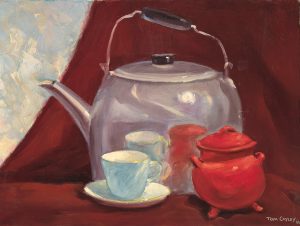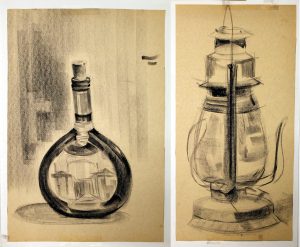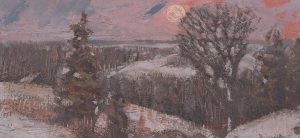A “still-life” is a piece of artwork that depicts inanimate objects, typically (but not always) everyday items arranged by the artist in a specific way. It’s a very old genre that stretches throughout art history.
There are many reasons why an artist may choose to create still-life art. Some are symbolic, with allegorical meanings assigned to fruits and flowers. The inclusion of skulls and hourglasses gained popularity in the 17th century in a style of painting called a vanitas or “vanity”, which was meant to represent the fleetingness of mortality.
Another reason why still life has stuck around for so long is because it’s a very good way for artists to practice and demonstrate their technical skills – especially things like lighting, composition, shape, as well as understanding how to depict different materials and textures. This still life painting by artist Tom Cayley in Homer Watson House & Gallery’s collection likely falls into this educational category.

During the 1970s when Tom and Ruthe Cayley ran the second iteration of the Doon School of Fine Arts, Tom was teaching plenty of students art fundamentals and would have been using his own works as teaching aids. This still life of a kettle, cup, and sugar bowl shows Tom’s artistic knowledge of painting different surfaces, such as metal, ceramic and fabric. Trickier aspects like the reflections in the kettle would have been useful for newer artists to watch a teacher do before trying it themselves.
A sketchbook labelled as “Tom’s Studio Demos” also contains examples that Tom would have provided for his students, such as these ones which illustrate how to capture the transparent, reflective qualities of glass.

Whether you’re a new or veteran artist, still lifes are a classic, useful way to get in some practice. They’re also very easy to set up using objects from around your home – and even show off a bit of your personality! What would a still life using your favourite foods or flowers say about you?

















